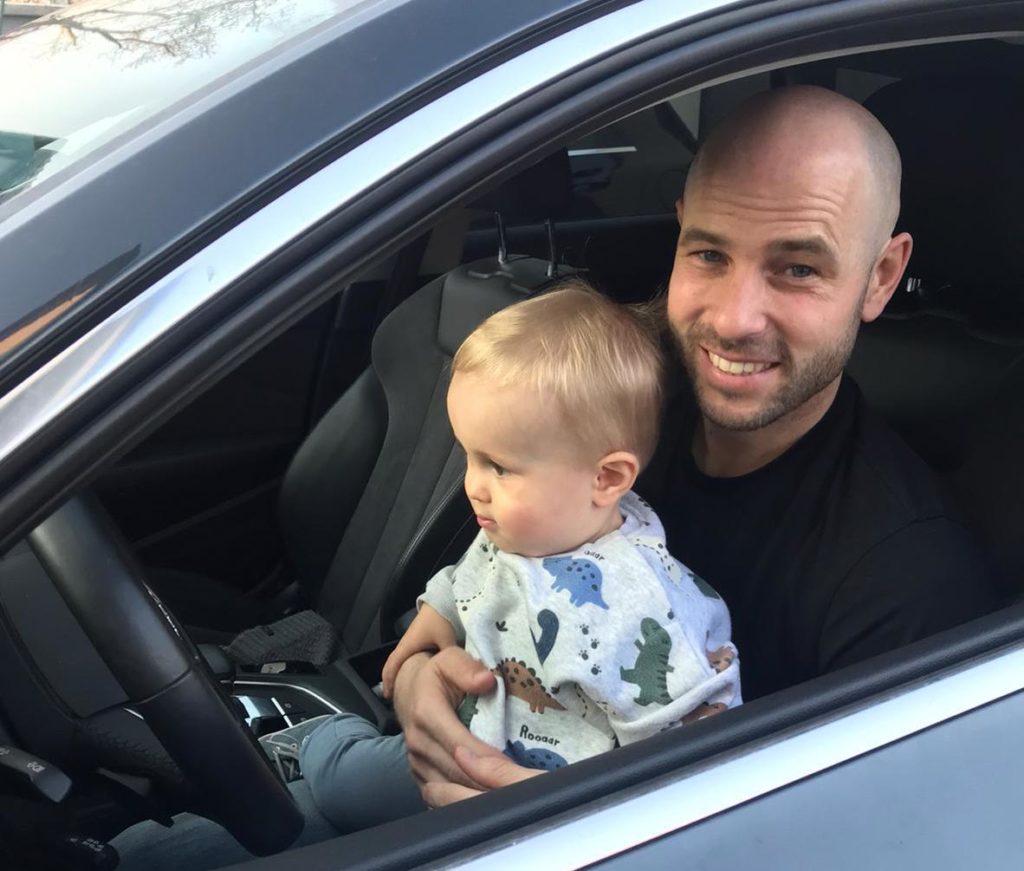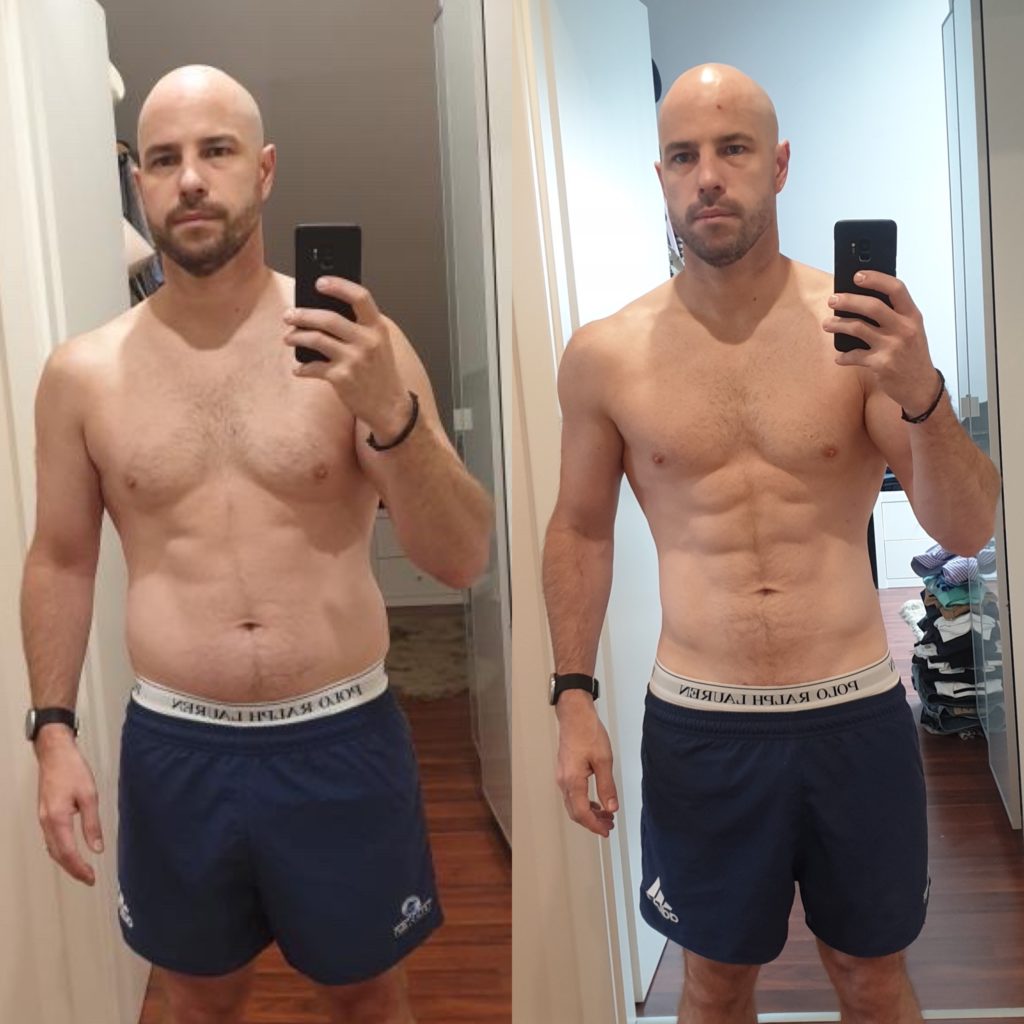David Boniface was 11 weeks into a new 16-week workout plan when COVID-19 forced his gym in Prague to temporarily close. Some people might use this as an excuse to fall off the wagon, to take an exercise break. Not Boniface, who realizes that he always feels better when he’s active. Not just physically, but mentally. He sleeps better, too. All of those things are especially important at a time when keeping our immune systems at their peak is crucial.
Since his gym’s closure, Boniface has found ways to exercise at home, helping him maintain the impressive results he earned during the first two-thirds of the workout plan.
Here, he talks about key nutrition lessons learned, why everyone should set micro-goals, and how things are rarely as bad as they seem.
Meet David Boniface
Age: 36
Location: Prague, Czech Republic (New Zealand ExPat)
Occupation: Finance Director, Business owner
Instagram: @djboniface
1. What inspires you to work out?
I always feel better when I’m active. I really believe that when training I’m the best version of myself. I went through half of last year with little activity as new fatherhood and work demands overwhelmed me and I got more down on myself as I got less active. It’s crazy how taking a positive step to train can trigger feeling so much better about everything. It helped get my balance back, flowing into my approach to my general outlook on life, my family, and my work.

2. When and how did you get started?
I always played a lot of sports growing up, but only really learned how to train properly in my late 20s. Last year however I just lacked motivation to get back into the old routines which were a bit uninspiring. I started the year way out of shape and found the 16-week Size, Strength, and Shred Cycle on HFP and got into it. The first few weeks were hard but after that, I was away.
3. Can you describe what your workout routines are like?
I tend to go through stages, changing routines every 6 weeks or so but generally, it’s always 3-4 days a week in the gym ranging from bodyweight to heavier depending on the program or goal, and 1-2 days of various cardio. Usually I’ll plan out 2-3 blocks of 4-6 weeks in advance. I also try and do at least 10 minutes of core work (plank variations, medicine ball) 4-5 mornings a week to start the day.
4. What is your diet like?
Kinda all over the place. I try to follow a 16:8 intermittent fasting routine with a basic focus on macros (45P/30F/25C) and necessary calorie intake (I tend to stick at around 1800 – 2000 a day but when losing, I was at 1500). It’s not overly scientific but gives me a good base from which I can be more strict when trying to lose weight, but also leaves some room to snack. Taking a little time to understand how macros relate to fueling the body and calorie totals was a huge help. I often have to grab a light lunch on the go so do need 2-3 protein shakes a day to maintain macro balance.
You may also like: How to become an intuitive eater
5. What have you learned about how your body responds to exercise and food?
Just how much better I feel when I get back into a training routine, better sleep and mindset and also the bad cravings fade away. I was also surprised how quickly I got used to fasting and training prior to my first meal (around lunch time). Big lesson was that I don’t need as much fuel as I thought I did and was just justifying snacking previously. These days I tend to feel my most exhausted after a few days without exercise, but that usually ties into more socializing and less ideal food and drink. I love a beer but it’s amazing how much it affects my sleep and recovery.
You may also like: 10 ways to get better quality sleep
6. When did you start noticing your fitness was improving? What did you think?
Pretty quickly. By week 3 my muscles were starting to at least feel like they existed, even if the weights being lifted were small, and by week 4 I was down a couple of kg and could see some changes in the mirror. My resting pulse dropped, and I was sleeping better. I was stoked as I had prepared myself for about 6 months before I thought I’d feel happy with my shape, but the early progress really motivated me.

7. Was there anything you struggled with through your process? How did you overcome it?
Any time you make drastic changes to existing processes, especially lazy ones, is tough. Early on I was just so unhappy with my shape it was hard thinking how long it was gonna take to get back where I wanted to be. I also had the gym close down after 11 weeks due to COVID-19 but by then I was on the wagon so found ways to exercise at home. The biggest reason I could keep going was that I had a set program to follow which was broken down into 4 to 6-week plans. That way I was only ever 2-3 weeks until hitting a halfway or completion milestone. Also, having an amazing wife who encourages and supports me helps to no end.
8. What’s your best advice for anyone just starting or wanting to make a change?
Don’t try and do too much too soon. Find a program that you can follow and work hard to stick to it for 3 weeks, after that you’ll be into it. If you try anything too complex or demanding too early there is more chance you set yourself up to fail. Also if you can break it down into 2 to 3-week boxes you’ll be achieving things regularly. Celebrate the small successes, half a kilogram might not seem like much but it’s better than nothing and shows progress. Also use whatever tools you need. I liked using MyFitnessPal to tracking my eating.
9. Anything else you’d like to add?
Understanding macros at a very high level and making an effort to count my calories and their sources made a world of difference to me. It was so eye opening to realize the calorie content and make-up of a lot of different foods (for better and worse). I also always try to remember that things are rarely ever as good or as bad as they seem. This helps keep perspective when I have my unhealthy moments or don’t hit goals and also keeps me going even when I do. Having blown out last year, that perspective is handy.
If you’ve got a story to tell, we want to hear it. Send us as DM (@humanfitproject) on Instagram, Facebook, or Twitter. Or, email us at info @ humanfitproject.com.

